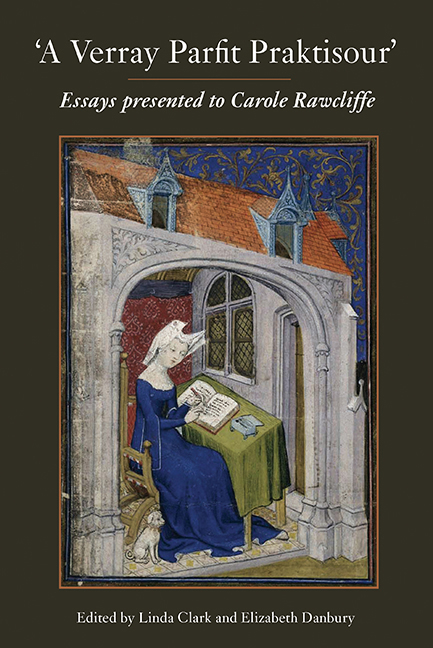Book contents
- Frontmatter
- Contents
- List of Illustrations
- List of Contributors
- Acknowledgements
- Abbreviations
- Tributes
- 1 Coslania, Norwich: an Archaeological Contribution to Early Medieval Urban History
- 2 A Queen in Rebel London, 1215–17
- 3 Defensive Officials and Defensive Levies in Fourteenth-Century Muster Rolls: an East Anglian Perspective
- 4 Lettice Oo? Queen Isabella's Accidental Apothecary
- 5 The First Instrument of Medicine: Diet and Regimens of Health in Late Medieval England
- 6 Politics and Piety: Norwich City Churches, Commemoration and Networking for the Afterlife
- 7 Telling the Time in Chaucer's London
- 8 The Bankrupt Bibliophile, William Paston, 2nd Earl of Yarmouth (1654–1732)
- 9 Ottomans, Neo-Ottomans and Invented Tradition in Hospital Music Therapy
- The Published Works of Carole Rawcliffe, 1976–2016
- Index
- Tabula Gratulatoria
1 - Coslania, Norwich: an Archaeological Contribution to Early Medieval Urban History
Published online by Cambridge University Press: 09 May 2017
- Frontmatter
- Contents
- List of Illustrations
- List of Contributors
- Acknowledgements
- Abbreviations
- Tributes
- 1 Coslania, Norwich: an Archaeological Contribution to Early Medieval Urban History
- 2 A Queen in Rebel London, 1215–17
- 3 Defensive Officials and Defensive Levies in Fourteenth-Century Muster Rolls: an East Anglian Perspective
- 4 Lettice Oo? Queen Isabella's Accidental Apothecary
- 5 The First Instrument of Medicine: Diet and Regimens of Health in Late Medieval England
- 6 Politics and Piety: Norwich City Churches, Commemoration and Networking for the Afterlife
- 7 Telling the Time in Chaucer's London
- 8 The Bankrupt Bibliophile, William Paston, 2nd Earl of Yarmouth (1654–1732)
- 9 Ottomans, Neo-Ottomans and Invented Tradition in Hospital Music Therapy
- The Published Works of Carole Rawcliffe, 1976–2016
- Index
- Tabula Gratulatoria
Summary
In 1390–1 a certain William Gerard was fined 12d. by the leet court of St Michael Coslany because he had ‘had a horse lying for a long time in the king's highway near the church of St Michael de Colegate to abominable offence and poisoning [of the air]’. This distinctly anti-social behaviour was noted by Carole Rawcliffe as but one example among many in her most recent book on communal health in late medieval English towns and cities. It is referred to again here because the ‘highway’ in question lies within Coslania or Coslany, a district within the northwestern part of later medieval Norwich that was also occupied by tanners in the Middle Ages, an activity itself noted for noisome odours. Coslany is bounded to the east by a low-lying area through which once ran the Muspole stream and to the west and south by the River Wensum. Thus tanning production, and perhaps even the horse, could have been smelt on the opposite bank of both the stream and the river.
Despite such proximity to the rest of the medieval city, however, the district has received scant examination from both historians and archaeologists, particularly when considering the origins and early development of Norwich. Indeed, it was characterised as ‘an archaeological wasteland’ in 1974, although this somewhat histrionic statement was qualified with the view that there was ‘no reason why its archaeology should not be as rich and varied as that south of the river’. Since 1974 there has been considerable archaeological work north of the river, although much of this has been concentrated upon the area to the east of Coslany, one now known to have been enclosed by an Anglo-Scandinavian defensive ditch and bank. Synthetic assessment of the pre-Conquest growth of settlement has necessarily focused upon this area, and Coslany, if not ignored, essentially viewed as tangential to an understanding of Norwich's early development. This essay, combining both archaeological and historical evidence, seeks to rectify this assumption and will endeavour to illustrate its Anglo-Scandinavian importance within the nascent urban community. It is not an attempt to detail or even outline the full urban history of Coslany; rather, it aims to illustrate how, within an ongoing debate about the origins of Norwich, the study of one small area can illuminate possible processes of early urban organisation.
- Type
- Chapter
- Information
- A Verray Parfit PraktisourEssays presented to Carole Rawcliffe, pp. 1 - 22Publisher: Boydell & BrewerPrint publication year: 2017



